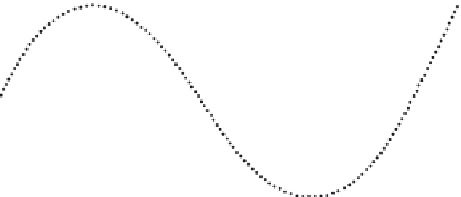Environmental Engineering Reference
In-Depth Information
logic low (0), which is lower leg in an inverter pole, is gated ON. Using these
definitions, the inverter output phase voltages (at the mid-points to negative rail) are
2
3
2
3
2
3
U
a
0
U
b
0
U
c
0
2
1
1
12
1
1
12
S
a
S
b
S
c
U
dc
3
4
5
¼
4
5
4
5
ð
6
:
8
Þ
Trzynadlowski [5] uses a discrete function of the inverter pulses to obtain the
average value of the switching function within the
n
th pulse as shown in (6.9)
where
a
n
is the
n
th pulse of an
N
-pulse per cycle sequence. The coefficients,
a
1,
n
and
a
2,
n
represent the turn-ON and turn-OFF angles, respectively, of the particular
pulse. The pulses are periodic with spacing
Da
. For example, refer to Figure 6.9 for
a description of the average switching function:
a
2
,
n
a
1
,
n
Da
n
¼
1, 2,
...
,
N
ð
rad
Þ
a
ða
n
Þ¼
ð
6
:
9
Þ
a
1
a
2
+
U
d
c
Δ
a
U
ab
a
1,2
a
2,2
p
/
w
a
2
p
/
w
a
-
U
dc
Figure 6.9 Illustration of average switching function
Furthermore, the average value of the switching function for phases
b
and
c
are
easily given by recognizing symmetry:
2
3
p
4
3
p
a
ð
w
t
Þ¼
b
w
t
þ
¼
c
w
t
þ
ð
6
:
10
Þ
Under sinusoidal modulation the average switching function must take on
values consistent with a modulation index (
m
i
) times the sine function, or
1
2
½
1
þ
m
i
sin
ðw
t
Þ
a
ða
n
Þ¼
ð
6
:
11
Þ
where the value of the sine modulation function is the value for
w
t
=
a
(
a
n
).




























